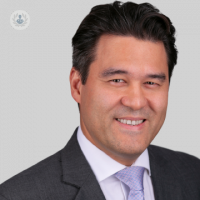How do I know if my baby has craniosynostosis?
Escrito por:Children born with craniosynostosis can experience problems with brain growth, head shape and facial function. Depending on the individual case, surgery could be needed.
Mr Juling Ong, leading consultant craniofacial, cosmetic and paediatric plastic surgeon, provides a comprehensive overview of the condition, including what exactly is craniosynostosis and at what age is craniosynostosis surgery done.

What is craniosynostosis?
Craniosynostosis is a rare condition affecting about one in 2500 babies that results in the skull plates fusing together earlier than they normally do. When this happens, it almost always changes the shape of the skull and sometimes the face, which can result in significant aesthetic concerns. Apart from the changes in appearance, though, these children are at risk of health problems, such as raised intracranial pressure as well as functional problems in the face if this is involved.
What causes craniosynostosis?
Although we can identify a particular genetic cause for a small number of patients with craniosynostosis, this is not the case for the majority of cases. A small number who also have another disease, will occasionally get craniosynostosis as part of their condition, but it is not a primary feature.
For the majority (about 80 per cent) of patients, there is no single known cause for their craniosynostosis, and so, we attribute craniosynostosis to a combination of factors.
When is craniosynostosis diagnosed?
In many cases, I find that the diagnosis of craniosynostosis is often suspected by the child’s parents. The baby’s mother will almost always have a feeling that something is not quite right and will turn to the Internet straight away to find answers. Parents really are the child’s best advocate and although it can be difficult to find good quality information, most parents will find enough to support their suspicions and push for a referral.
As a craniofacial surgeon, I will often be able to confirm the diagnosis at the first appointment or reassure families that their child is healthy. In a few cases, further investigation with a CT scan may be required.
What are the long-term effects of craniosynostosis?
With the right care, the majority of children with craniosynostosis will live happy and healthy lives.
If your child has craniosynostosis, it is really important to have them assessed by a specialist in craniofacial conditions such as craniosynostosis, to ensure that they get this care. This will include monitoring them at regular clinic appointments, to ensure that any problems are detected early enough to allow treatment before there are any long-term effects.
Can craniosynostosis be fixed?
Certainly, there are treatments that can alter or correct the head shape differences that children with craniosynostosis have. There are also very effective operations that can enlarge the skull to treat raised intracranial pressure, which also improves the skull shape. So, in this sense, craniosynostosis can be fixed. We do not yet have a way of preventing craniosynostosis from occurring in the first place, so it is really important for children to be referred as early as possible to ensure that any problems are detected early and that all treatment options are available to them.
At what age is craniosynostosis surgery done?
This is very much dependent on each case. The main indications for treatment are to alter head shape and to treat raised intracranial pressure. If I suspect raised intracranial pressure or significant functional problems in a child with craniosynostosis, then surgery is usually recommended as soon as possible, irrespective of age. In general, though, skull surgery is performed in the first two years of life, with some of the minimally invasive procedures needing to be performed much earlier, before five or six months of age, to achieve the best results.
In children with syndromic craniosynostosis, there is also undergrowth of the facial bones which may have really significant effects with how these children breathe and eat. An underdevelopment of the eye sockets can make it difficult for them to close their eyes, which ultimately can be a risk to their vision. In these rare cases, I may recommend surgery in the first few years of life. In those without significant functional problems who want to alter their facial appearance, there is a real benefit in delaying surgery until they are a little older. This enables me to really involve my patients in the decision-making process for these appearance-changing surgeries. The changes we make, will be more predictable and long lasting.
If you would like to seek expert diagnosis and treatment for your baby’s craniosynostosis, or simply wish to know more about the condition, don’t hesitate to visit Mr Ong’s Top Doctors profile today.


